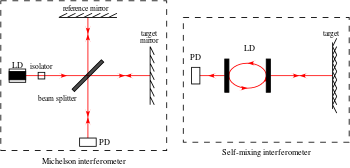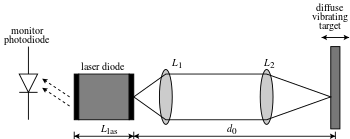Self-mixing interferometry
Self-mixing interferometry is a measurement technique, in which a laser beam is reflected from an object, back into the laser. The reflected light interferes with the light generated inside the laser, and this causes changes in the optical and electrical properties of the laser. Information about the target object and the laser itself can be obtained by analysing these changes in behaviour.[1] The technique is also known as feedback interferometry, induced-modulation interferometry,[1] or backscatter modulation interferometry.[2]
Background

Laser interferometry techniques are widely used in a range of sensing applications, including the measurement of vibration, displacement and velocity of objects.[1] These methods involve the mixing (or superposition) of coherent light waves. Typically, the light from a laser is split into two. Each beam follows a different path before being recombined. A detector is then used to measure the intensity of the light. The Michelson interferometer and Mach–Zehnder interferometers are examples of such systems.

In contrast to conventional interferometers, the interference in self-mixing interferometers occurs in the laser cavity between the internal optical field and a beam backscattered by an external target. The variation of the optical path length causes fluctuations of the back-reflected phase signal. The back-reflected phase signal enters the laser cavity and causes a modulation of the laser. Thus, the optical power of the laser is a modulated waveform. This waveform of the optical output power can be used to estimate the target velocity.[1]
References
- 1 2 3 4 G. Giuliani; M. Norgia; S. Donati & T. Bosch (2002). "Laser diode self-mixing technique for sensing applications". Journal of Optics A. 4: S283–S294. Bibcode:2002JOptA...4S.283G. doi:10.1088/1464-4258/4/6/371.
- ↑ de Groot, P. J., et al. (1988). "Ranging and velocimetry signal generation in a backscatter-modulated laser diode." Applied Optics 27(21): 4475-4480.
- ↑ G. Plantier; N. Servagent; T. Bosch & A. Sourice (2004). "Real-time tracking of time-varying velocity using a self-mixing laser diode". IEEE Transactions on Instrumentation and Measurement. 53.